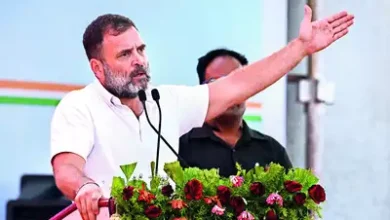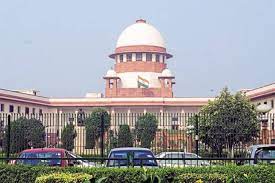Politics and Pilgrimage Coexist in Varanasi
Varanasi rises early, like a devoted pilgrim. At four-thirty in the morning, a street vendor selling pooja paraphernalia cries out, “10 ka, 10 ka, 10 ka.” At the Dashashwamedh Ghat, hawkers shaped like hawks pounce on foreign visitors, offering a variety of services like a free locker, a boat ride, and a neck massage. The owner of a food stall slaps dosa batter on a griddle. A bright paan shop has several customers waiting outside. Over one hundred people have gathered at the Ghat, where among a jumble of boats, devotees and diyas bob on the Ganga. Dashashwamedh is flooded with contradicting tales: two guys sleeping on a platform, a young lady applying lip liner, a man shaving his head without a shirt on, pilgrims playing in the river, an elderly man ringing the Ghat bells, and an angry Hanuman flag flapping on a boat. All in the early gloom; the sun moves slowly here, not like in Varanasi.

The ghats of the city never end. The customs around them are also. However, its Member of Parliament (MP), Narendra Modi, has started to mold Varanasi into his own image, only a short distance away. Beginning in early 2019, his passion project was a complex surrounding the Kashi Vishwanath temple, built by the Maratha monarch Ahilyabai Kolkar a century after Aurganzeb had destroyed it. It reversed the Hindutva battle cry, “Ayodhya toh sirf jhaanki hai, Kashi aur Mathura baaki hai” (Ayodhya is merely a peek, the complete view—of Kashi and Mathura—is unfinished), prior to the building of the Ram temple.
In addition to displacing neighbors and imposing similar aesthetics—down to the stores’ signs on the redesigned roadways, which have the same color, design, and font—both projects have produced opulent complexes. Many years after the first performance, most Varanasi boards, with their haphazardly missing letters, still don’t pretend: “Garment” has no N, “Store” has become “Sore,” “Gandhi” is “Gadhi,” and “Vastralay” has no L.
The Kashi Vishwanath avenue blends commerce and devotion, much like the Ram temple. It has a food court, a bookshop, and a multipurpose hall that may be rented for Vedic marriage, Upanayan, and haldi ceremonies. Donation boxes are fueled by HDFC Bank, ATMs are provided by SBI and Canara Bank, while LIC provides free water. The sumptuous hallway that connects the Manikarnika Ghat to the main temple might make you forget that you are passing through a former temple, store, or bedroom. It is reached by riverfront stairs and canopy-shaped shelters. A demolished ashram and a school are located next to the Kashi Vishwanath complex, which is one of the few remaining remnants of that devastation.
The nearby Gyanvapi mosque seems paler due to its crumbling domes. I was denied entry to the mosque by two police officers who were around 50 meters apart. They repeatedly used the same excuse, stating that Hindus are not allowed on the disputed land. Local Muslims are allowed to worship inside, but police officers go through the IDs—and sometimes even Aadhar Cards” of “suspicious” Muslims, those whose faces they don’t recognise or who exhibit telltale signs of being foreigners, like not knowing where they are or asking for directions. Like you, I repeatedly asked police officers for advice on how to enter the temple, but I was never made a suspect. In Varanasi, you might be a lost Hindu and not a lost Muslim.
His city is a tribute to diversity, much like the many incarnations of Shiva—a creator and a destroyer, a hermit and a spouse, a cave dweller and a bhang-guzzler. Simply go the two kilometres between Dashashwamedh and Assi Ghat to see the incredible range of castes, architecture, origins, regions, and traditions. There are four types of hats: Janki, Tulsi, Nishad, and Jain. They are tidy and peaceful, with restrooms, trash cans, and changing areas spaced out at regular intervals—one of which is floating over the river. One 72-year-old priest at Dashashwamedh Ghat adds, “Modi accomplishes what he promises [such as creating the temple corridor and restoring the Ramnagar bridge]”. “Son, I have never in my life seen a PM like this. We feel as if we have discovered God throughout the last ten years.
An eighteen-year-old kid sits not far from Tiwari, behind a sign that reads, “20 year experience, lifetime practitioner, Banaras Hindu University.” Ayush Shukla is studying Veda with the hopes of becoming an astrologer, much like his master. He commends Modi for restoring the ghats, pointing out the “changing rooms for our mothers and sisters” in particular. He then goes into a passionate speech about a shivling that can be found in Gyanvapi, how Hindus are “lacking unity as compared to Muslims,” and how it is now “Mathura’s turn” after Ayodhya and Varanasi. A guy with glasses named Gyan Chandra sits next to him and begins to sing his own song, which is really composed of verses from the Ramcharitmanas. He also explains the meaning of the term “mandir” and refers to Modi as “a guide for Hindus.”
On the approach to Assi Ghat, the tales keep changing: a young blue-collar worker, wobbling and slurring, begs for a cigarette; architecture students from a Gujarati college inspect the Tulsidas Ghat. A baba requests Rs 1,100 to have his picture taken. Wide shelters, an LED screen showing advertisements, and a food street are features of the renovated Assi. Manab Pramanik and Chotu Biswas, two guava vendors on opposite sides of the ghat, are impressed by the recent developments (and their architect, Modi): a flourishing enterprise, a growing city, and an elegant ghat (“which was just a drain before”). But they disagree on one very important point. According to Pramanik, “[Gyanvapi’s] current structure should remain intact.” “You maintain your faith, I maintain mine,” Biswas chuckles. “The mosque won’t last for long—and it shouldn’t.” “Modi is dabang; he’ll make it disappear.”
“Balwa ho jayega [a riot will break out],” a guy standing next to him says. “Nothing will happen,” Biswas responds. “Ayodhya is Ayodhya,” the guy remarks. However, if anything similar occurs in Banaras, both you and I will collapse. How would you feel if I tore down your home and installed a toilet there?”
The Harmony Book Shop is located less than five minutes away, and its proprietor, Rakesh Singh, has lived in the city for fifty years. He has also seen the unheard-of changes that have occurred recently, including the loss of tranquility, the increase in tourists, the shift from “pilgrims to picnics,” and the age of the tourists—many of whom are in their early 20s. He inquires about their reason for visiting Varanasi when they arrive at his business. One lady was more explicit: “[The social media influencer] Beer Biceps.” He claims that the reason for the city’s prominence is not internal, but rather the result of someone influencing one’s thoughts. “Most of them say two things: Instagram posts and reels.” It’s romanticizing an irrelevant idea.
The sounds of shehnai on the radio are joined by a few people entering the shop, taking off their shoes close to the entrance, and picking up books with plastic covers while Singh is still speaking. Singh retorts, “But they had to leave,” if those on the ghats and in other parts of the city applaud Modi and downplay any worries about those who lost their houses and businesses by claiming that “they got twice the original amount.” He continues, “You can’t erase the past. Development must be inclusive, balanced, and holistic. They didn’t do it voluntarily.” Furthermore, the Banarasis who were forced to flee their homes must be experiencing “haunted nostalgia” since they have moved to places where they have no friends, relatives, or memories. It is impossible to quantify in monetary terms. The people who discuss large compensations are those who have not experienced home loss.
However, Varanasi’s gullies are one feature that haven’t changed throughout the years. Their narrowness, less than 10 feet wide, contrasts with their turmoil and ambition. Apart from stores on both sides, they often accommodate people, bicycles, scooters, bikes, Activas, cows, dogs, and whatever else that needs to fit in this other reality where time and space are disconnected. That traffic in gullies flows both ways is what improves (or worsens) the situation. For more than a few seconds, you are unable to walk straight. You shift to the left to make room for a bike, but what about the scooter approaching from behind? Something has to be confusing and distracting you. Something as simple as a few dogs pursuing a cow may suddenly push you into the wall. People ride their bikes like they’re on a six-lane freeway, and in the middle of all the cramped chaos, the stunning murals that portray important mythical moments nudge you to slow down. Banarasis and their gullies are really designed for each other; the norms of the outside world don’t apply to them.
A tangle of these gullies, bursting with shops, marketplaces, and shopping centers, is located around one kilometer from the Kashi Vishwanath temple in the Daalmandi area. There, bagpacks, niqabs, and kurtas are hung from tarpaulins protruding from businesses. As a steady stream of men and women in burqas and prayer caps pass by, hawkers stutter to draw customers (“Bees rupees mein kangan”, “bachchon ka kapda”, “make-up ka saamaan”—bangles for 20 and clothes for kids, make-up equipment). A tea vendor clangs ceramic plates as he walks. Scarcely any space for standing, sitting, or walking, yet the alleys are teeming with people, commerce, desperation, and a message: a guy riding a bike with a Jai Shri Ram banner, covering his head with a saffron gamcha.
Locals said that this turmoil had consorts in the decades before and after independence, and this market was a mehfil. The businesses were above the two-story dwellings that emitted music, including tabla, shehnai, thumri, and aalaap. The Banaras gharana’s doyennes of Hindustani classical music, Jaddan Bai, Husna Bai, Rasoolan Bai, Gauhar Jaan, Siddheshwari Devi, Nirmala Devi, and a few more, were created by Daalmandi. But it all came to an end in the early 1970s, when the tawaifs ran into financial difficulties and were driven out by the police, who treated them like prostitutes.
Even now, it’s hard to discover even traces of them in Daalmandi—Lachhu Maharaj’s haveli, for example, is now a little commercial center with mobile accessory sales—but Ustad Bismillah Khan’s residence still survives. But it’s not simple to find. The store owners gesture to a sequence of ravines that become smaller as you go. Outside his residence, which has the nameplate “Bharat Ratan Ustad Bismillah Khan,” a road is clogged with bikes and rubbish, and at 2:50 pm, a street light burns in a city that often has power shortages. Legendary musicians seem to live forever, but this dilapidated home gives the impression that Khan never was.
Beside it is seated Nasibullah (“urf Kallu”), a 75-year-old shopkeeper who is almost as old as India and who discusses the progress and disillusionment of the city. Similar to Singh, he describes how the corridor project has limited development to a narrow region around the Kashi Vishwanath temple, increased traffic, and disturbed “sukoon.” He used the collapse of Daalmandi as an example, describing it as a filthy neighborhood (“these lanes were swept twice a day—the gullies used to glow”), an uncontrollably expanding market (“from 100 to 2,000 shops”), and declining profitability that resulted in “bhookhmari.”
There are no YouTube clips or Instagram reels featuring this Banaras. This Benaras lacks “I ♥ Kashi.” This Banaras stumbled into the platform after attempting to jump aboard the Viking train. Two days after the district court permitted Hindu prayers in the Gyanvapi basement, on February 2, 2024, a startling silence swept across Daalmandi, with several businesses remaining closed. A month later, the Varanasi Nagar Nigam’s revised recommendation was implemented by the municipal corporation, which closed 26 meat businesses, some of which were in Daalmandi, within a two-kilometer radius of the Kashi Vishwanath temple. In addition to the meat prohibition, Councillor Indresh Singh proposed two other modifications, all of which were approved: 145 local businesses’ rents to be raised and the roads in Daalmandi to be widened to provide easier access to the temple for Hindu visitors. A shopkeeper replied, “The new tawaifs have arrived, but the old ones have left.”
Varanasi, like other Indian towns, is full of contradictions: it is both ancient and modern, sultry and dusty, neglected and developed. The latest illustration of this can be seen at NaMo, the ghat that was opened less than two years ago. Tourists imitate the stance and have their photographs taken with the three bronze sculptures of folded hands, which stand 25 and 15 feet tall, respectively. A fourth statue, standing 75 feet tall, is being built; it will be larger than the others put together.
This Ghat also forces you to consider Modi, the guy who is creating and destroying Varanasi, as well as his competitiveness and ultimate objective. Not with Nehru, please. Look elsewhere and use your discernment. Let’s begin with his constituents resounding with “Har Har Mahadev” shouts. Modi replaced Mahadev in its MP’s 2019 election campaign. Even the “NaMo” Ghat serves two purposes: it honors Modi with his acronym and invokes the Almighty through a Ganesh mantra (the words “Namo Namah” are actually written on two vertical slabs that bookend the sculptures).
The flashy promenade, complete with a splash pool, inflatable castles, trampolines, and toy rides, has enough unique elements (enhanced by attractive lighting) to generate visually appealing images that might prompt a lot of people to snap pictures. It makes sense—a government adept at social media would know how to generate points for selfies. Another thing the NaMo Ghat does by fusing old customs with contemporary flair is making Hinduism hip. Particularly for the youth of India, who make up a significant portion of the populace and are susceptible to the influence of pro-government figures who, as an extra bonus, were honored with National Creators Awards handed by Prime Minister Modi two months ago.
Ram is present in Banaras despite the fact that it is known as the city of Shiva. His bhajans are performed at the ghats, his big images hang in stores, and you can even hear the intermittent chanting of “Jai Shri Ram” outside the temple. What is just as remarkable? outside least two police officers wearing tilaks and saffron vermillion on their foreheads were stationed outside the Kashi Vishwanath gate on April 25. As he was leaving via the same gate, a second police officer pointed up toward the temple and said pranaam.
Beside it stood a gold-coloured figure of the Nandi bull, adorned with a loincloth and a garland. In the hopes that Shiva would hear their whispers, devotees stood in a line close to it. It’s also said that Nandi and the god are inextricably linked and that nothing can stand in their path. However, the rear of this Nandi was facing the Kashi Vishwanath temple. What did it instead face? The Gyanvapi mosque is where a lot of Hindus, including the Modi administration, believe the real Shivling is kept.
Beyond the mosque grills and the temple entrance, just across from Nandi, was a Gyanvapi basement, also known as “Vyasji Ka Tehkhana.” The basement was illuminated by large lamps; behind a saffron fabric adorned with over a dozen Om signs, three idols were perched on a raised platform. Numerous worshippers stood outside, closed their eyes and pressing their hands. And at that moment, the whole mosque seemed to have vanished from their perception; instead, a temple appeared in front of them as well as in their bodies, brains, and souls. I was informed by a number of Banarasis that God resided inside them, that genuine faith had the power to transform a stone into a god, and that the name “mandir” itself derived from the words “man,” which meant “heart,” and “dir,” which means “place to stay”: “So where does the Lord stay? inside our hearts.
Three large monkeys bolted out of the temple and jumped inside the mosque while the prayers went on. “Kabhi bhi Hanuman-ji ka akraman ho sakta hai,” said a police officer with a handlebar mustache (Lord Hanuman might strike us anytime). The monkeys gave him a fierce look, causing the guy with the saffron hat to shrink back as he peered inside the mosque and said, “Jai Bajrang Bali.” They persisted in leaping over the edge, causing a little panic among the pilgrims. With a bhajan playing in the background, “Tu hi bigaade, tu hi sanwaare, Is jag ke saare kaam/Hey Ram, Hey Ram (You create, and you destroy this universe/Hey Ram, Hey Ram),” they soon descended from the grills and strolled along the road leading to a security checkpoint.







